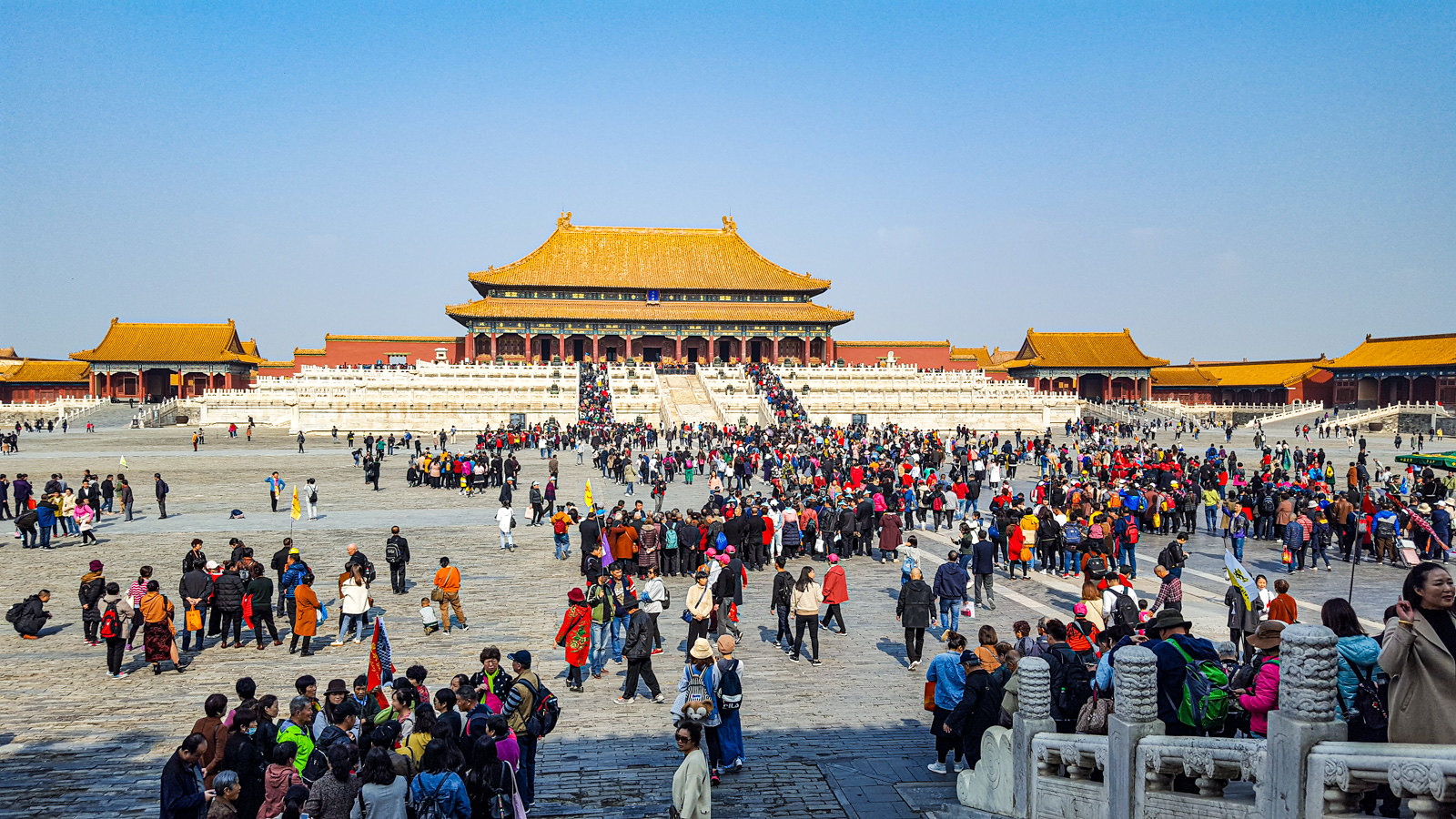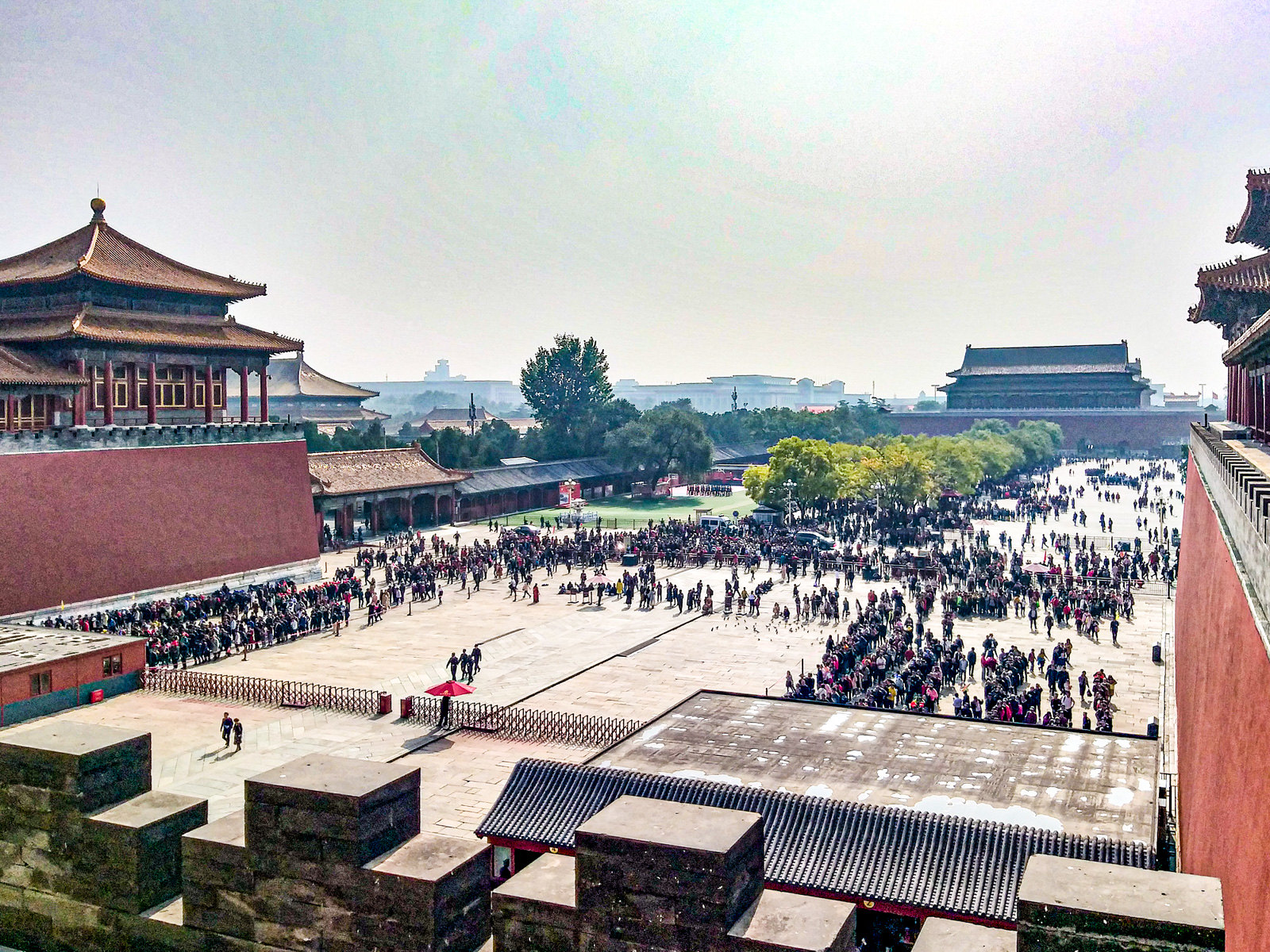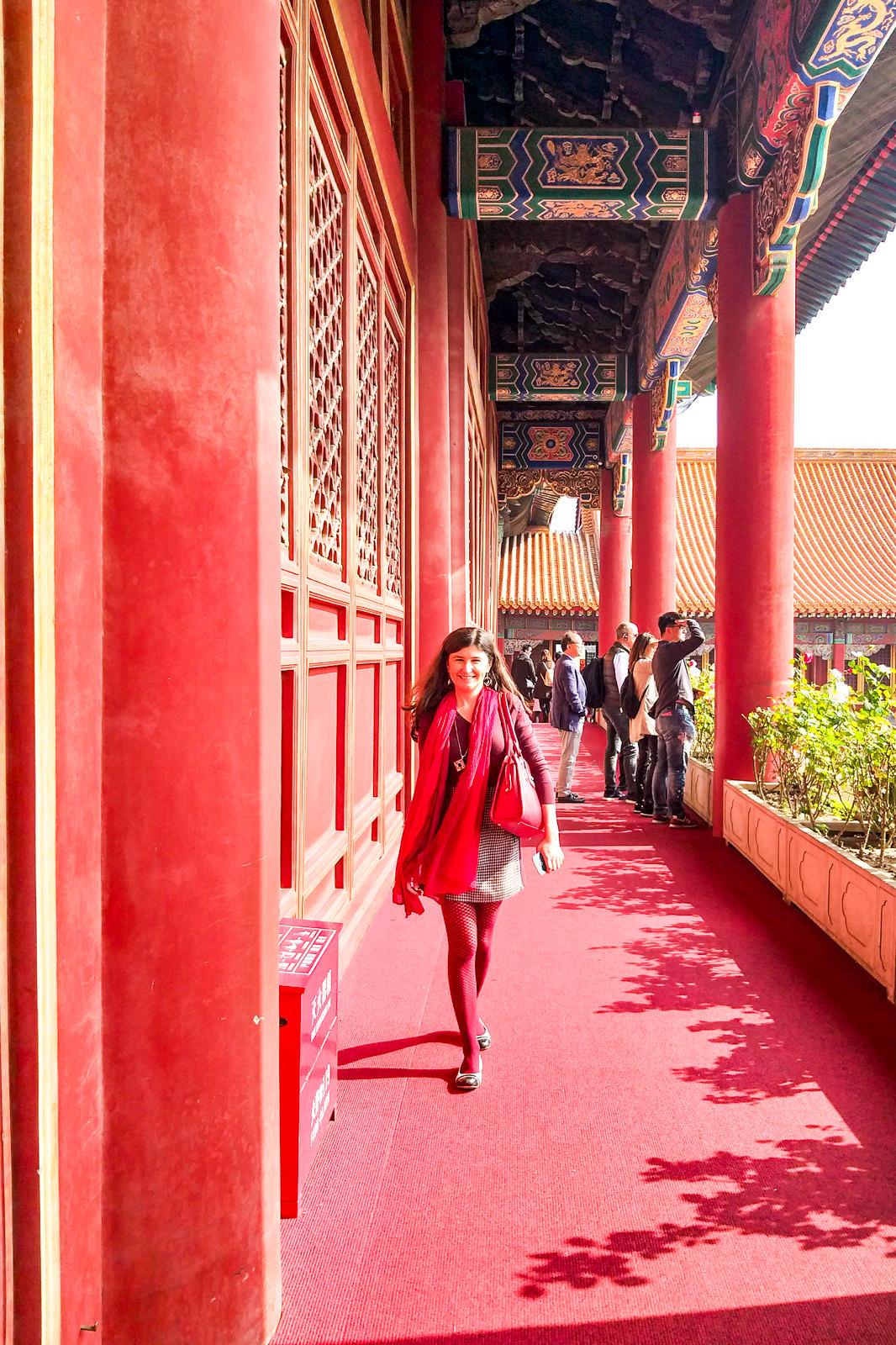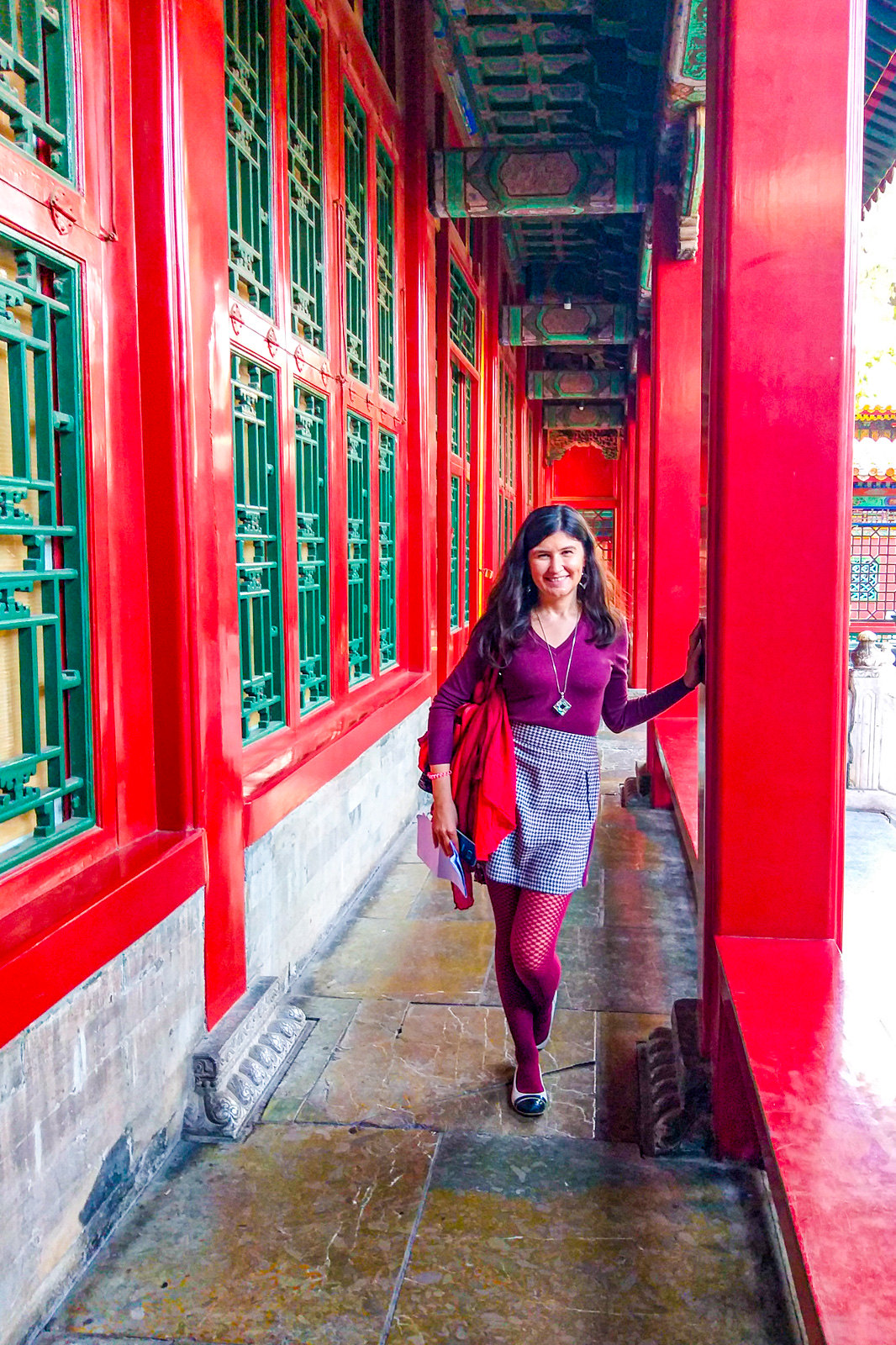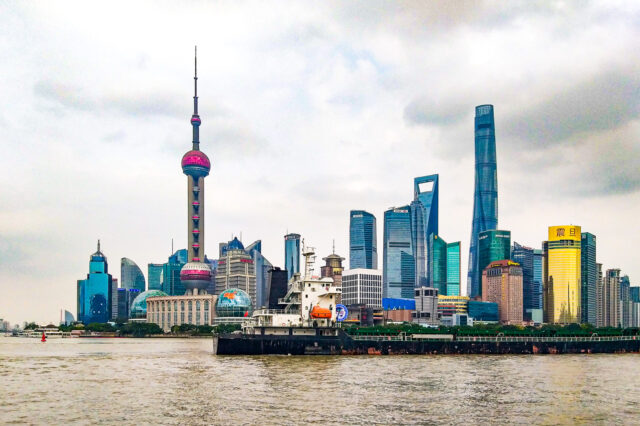I guess hardly anyone hasn’t heard of the famous Forbidden city. Built at the beginning of the 15th century this palace complex served, as the main Imperial city of the Ming and Qing dynasties. The city was forbidden for the commoners to enter, that’s how it got its name. Anyone trespassing would be executed on the spot. From 1911 the Emperor lived in the inner court (North) area, while the rest of the palace complex became a museum. While in 1924 the last Emperor was evicted.
The City is now the best preserved palace complex in the world. It was enlisted, as the UNESCO World Heritage site.
Practical Details for Visiting the Forbidden City
How to get to the Forbidden City
The route for a visit of the Forbidden city goes from South to the North simply because you are only allowed to enter from South and exit from the North side of the city.
If you are coming after visiting the Tiananmen square, you will have to cross the street through underground passage. The passage will be on your left, towards the west.
You can also come to the city from the Tiananmen East or Tiananmen West metro stations located nearby.
After getting out of the forbidden city, it is difficult to find transport, as there is no metro station immediately closeby. So I suggest to visit Jinshan park and/or Beihai park and walk to the Beihai North metro station.
Tickets for the Forbidden City
You can buy tickets at the ticket office of the Forbidden city itself. All Chinese have to have online tickets in advance and only foreigners are allowed to buy them on the spot. One thing we didn’t realize was that to get to the ticket booth, which isn’t indicated here, you will have to go through several gates. That confused us quite a lot, as I expected to find ticket office somewhere at the very entrance. But we passed three gates and still didn’t see the ticket booth. So we found a guard and showed him the Google translate with the question on how to find the booth. Apparently, we still had to pass a big courtyard, before we got to the ticket booth on our right-hand side. The booth is next to the security check, so you shouldn’t worry, as you won’t easily miss it, just keep in mind that it isn’t at the very entrance, you should pass several gates and courtyards to get there.
Don’t forget to bring your passport, as it is your ticket. I guess the only English phrase the people at the palace know is: “passport is your ticket” 😊. The tickets cost 60 yuans during the high season (40 yuans during 1 November-31 March) and 20 – for the students. I also wanted to get the tickets for the clock museum and treasury (10 yuans each), but I couldn’t make them understand. But don’t worry, you can get these tickets inside as well. Just make sure to be at these ticket offices before 3.30 pm, as the two museums close at 4pm, an hour before the whole site closes at 5pm. In winter they close even earlier, as the city closing time is 4.30pm.
Alternatively, you can reserve your ticket online at the official site. This is a bit of a hassle, as you will have to send your passport copy and other personal details to their email address. I believe you would then have to pay at the ticket office for your reserved tickets. So unless you are visiting during a very busy period and think that tickets may be sold out, I suggest to simply turn up and buy your tickets on the spot.
Note: While getting your tickets, make sure to go to the official ticket counter and don’t follow anyone, who tells you they know a better way. I have heard of the so called teahouse scam, where they take you to the teahouse and charge exorbitant prices.
Comprehensive map of the Forbidden City
While planning my trip, I was rather confused about what to visit inside the Forbidden City, as I like planning everything in advance and not missing the things I want to see. People kept saying, that you won’t be able to see everything anyway, so you have to choose. I didn’t want to just visit the major buildings, so I looked for the most comprehensive map of the area I could find.
This map from TravelChinaGuide seemed was the most comprehensive from what I found and it helped quite a lot. With this map we explored all the major places we were interested in.
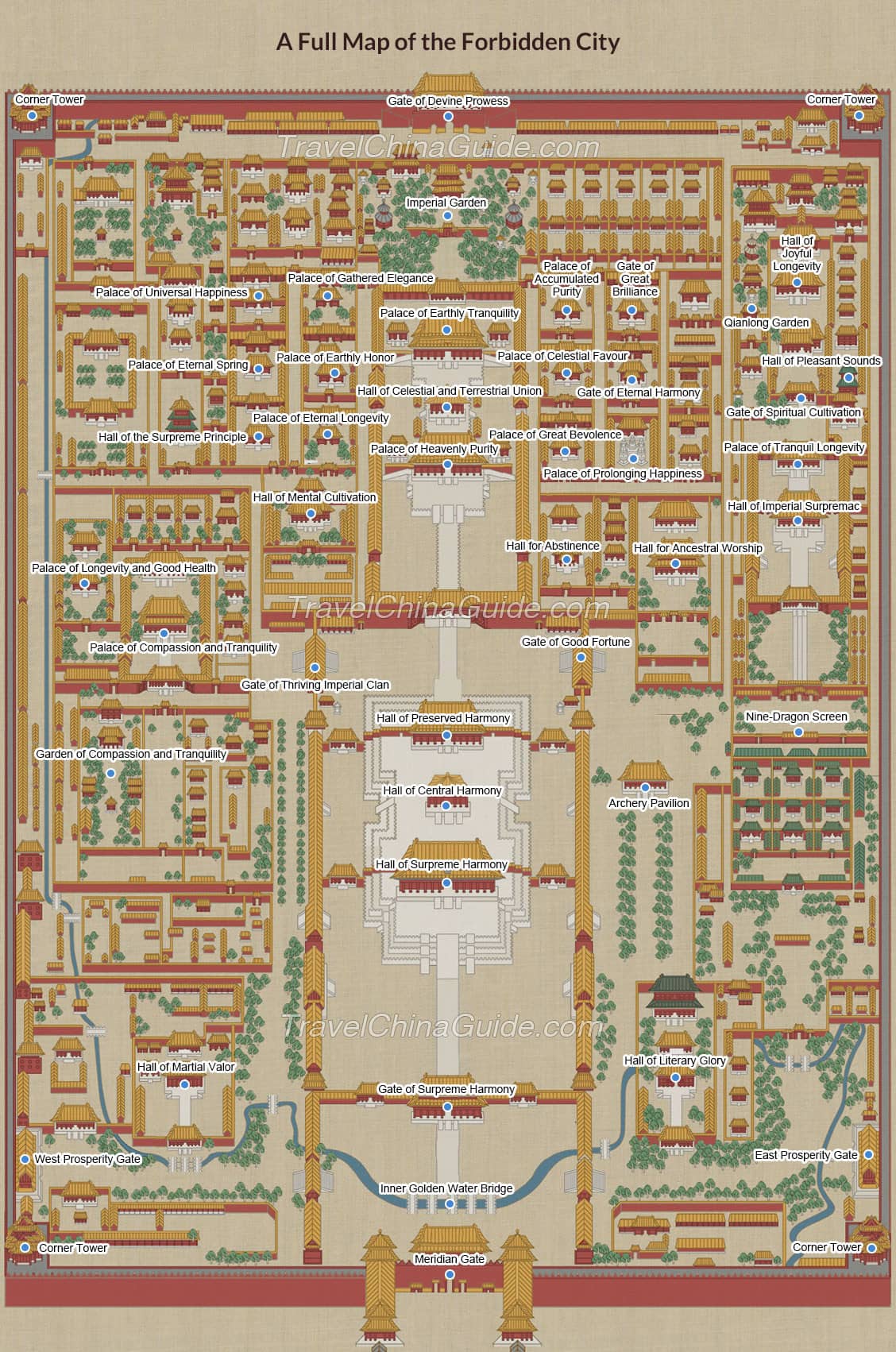
How much time do you need at the Forbidden City?
It depends how much of the City you want to see. If you follow the route below and want to see most of the things around, it will take you from 4 hours to the whole day, depending on your pace.
The Palace is immense with 980 buildings consisting of 8,700 rooms. Many tour groups visit the 6 central halls and don’t bother with other buildings. However, I definitely suggest to explore much more than that. My guide below is designed to maximize your day at this magnificent palace complex.
We did spend the whole day there and made sure we explored all parts we were interested in – entered at about 9.30 and exited by about 4.45 pm and headed up the Jinshan park to see the views over the forbidden city.
The sightseeing route
You could simply go straight through the major halls from South to North and finish your route in 2-3 hours. However, below I will give you the details of how to explore other parts as well.
Note: Funnily, depending on the translations, the names of the buildings you will be seeing in different sources might vary. For instance, the Hall of Martial Valor or Military Eminence is the same building. Here I am using the names on the map above to make it easier for you to orient yourself.
Outer Court (South Side)
We entered the Meridian Gate at about 9.30am. The crowd at that time was manageable. There was no queue at the tickets booth and we passed the security check quickly. However, an hour later far more people, and especially tour groups arrived. So, as other travel guides suggest, arriving early will really give you some time with a bit less crowds.
This was the queue for the security gate at about 10.30am. We managed to get in earlier than that and didn’t have to queue.
We also climbed up the Meridian gate. It has some lovely corridors. Plus, it provides some nice views, if you have time and energy to do so.
To get a good picture of the Gate of Supreme Harmony and of the water bridges, after you pass the Meridian Gate, you should go to the left or right of it, where you will find less people and will actually be able to breathe 😊 By the way, the gate has large pair of bronze lion statues in front of it.
Another way to hide from the crowds time after time is to go to the smaller buildings on the right and left of the main courtyards. It gets quite suffocating, after being here for a while with so many people. So, do check out the Hall of the Literary Glory (see on the map on the right side of the Gate of Supreme Harmony). This actually consists of two main buildings, with the first containing porcelain and ceramics gallery. The second building is also very interesting with the green roof. This used to be imperial library or Confucian Hall. We did like it and there were very few people around.
We also noticed these lovely ladies nearby, who were more than happy to pose for us.
On the West side, you will find the Hall of Martial Valor (or Military Eminence). It houses paintings and calligraphy gallery.
Next, we followed the main route passing the Halls of Supreme Harmony, Central Harmony and Preserved Harmony. All the halls are closed off and you aren’t able to enter them. You can only get a peek inside, if you manage through all the huge tourist groups. But the exterior is beautiful, so you can sit and marvel at these amazing buildings.
The Hall of Supreme Harmony was the main site for celebrations held during the Qing dynasty. The Throne you will see inside is interesting with the golden dragon carvings on it.
The smaller building behind – the Hall of Central Harmony was the site, where the emperor stayed the night before the celebration and where he met the high-ranking persons.
Beside, apparently, you will find 10,000 dragons carved into the interiors and exteriors of these three great halls, which is fascinating. Don’t forget to look at the roofs. In the corners you will see a number of dragons preceded by the Emperor sitting on a dragon. The number of roof eaves tell you the importance of that particular building and the people living in it. The Hall of Supreme Harmony has 10 eaves (I didn’t count them, just read about this 😊).
Inner Court (North side)
Next, The Hall of Heavenly Purity was the residence of emperors, before moving it to the Hall of Mental Cultivation (which is located slightly towards the West – see below). This building later became a throne room. After this, you will see the Celestial and Terestrial Union, followed by the Hall of Earthly Tranquility, which used to be the Empress’s residence, but later on became a shrine.
Start exploring the East side of the palace with Qianlong garden and the Hall of Joyful Longevity. The Hall of pleasant sounds houses the theatre stage built in the 18th century. After you exit the gardens, head to visit the six Eastern palaces, the passages are the most interesting for me here.
Next, do visit the Treasury (Which is located at the Palace of Tranquil Longevity e.g. Peace and Longevity). As I mentioned this ticket booth and the museum close earlier than the City closing time. It really is worth your time and the additional 10 yuans (you can buy the ticket at the entrance or at the main ticket office). When you enter, you will find the Nine dragon screen. Then you can enter the halls to marvel at the interesting golden and silver objects from the Imperial times. Do go through the whole length of the treasury.
The entrance to the Hall for Ancestral Worship, where the clock museum is located, is near the entrance to the Treasury. You can buy the tickets in front of the Hall entrance and they cost 10 yuans (or you can buy tickets in advance at the main ticket office).
After exploring the East side of the palace, head to The Hall of Mental Cultivation, where the emperors resided (after the residence was moved from the Hall of Heavenly Purity), is located on the west side of the main courtyards. It was under renovation, when we visited in 2019, however, you can visit it now.
Next, go more East to the Palace of Compassion and Tranquility, which used to be the residence of Emperor’s wife.
Finish your visit by wondering around the Imperial garden. Unlike the tranquil and cute gardens, you will find in some places in Suzhou, for instance, this is an extremely crowded, loud and small place. But you will still get an idea of how a traditional Chinese garden looked like with its many symbols, such as pavilions, water, stones, round gates.
What to do next
As I mentioned above, you can’t exit from the South. You have to finish your visit in the North side of the City. After exiting the Gate of Divine Prowess, it would be rather difficult to find any transport to leave the area. The nearest metro stations are quite a long walk away and figuring out the routes of the buses is really complicated, as there is no English information online or on the spot.
I suggest heading up the Jingshan park hill. For this, you will have to cross the street. You will find the underground passage on your left after exiting the city. The Jingshan park tickets cost 2 yuans and the climb of over 300 stairs is definitely worth it.
Find the rest of the information about visiting the park and other sites in Beijing here.
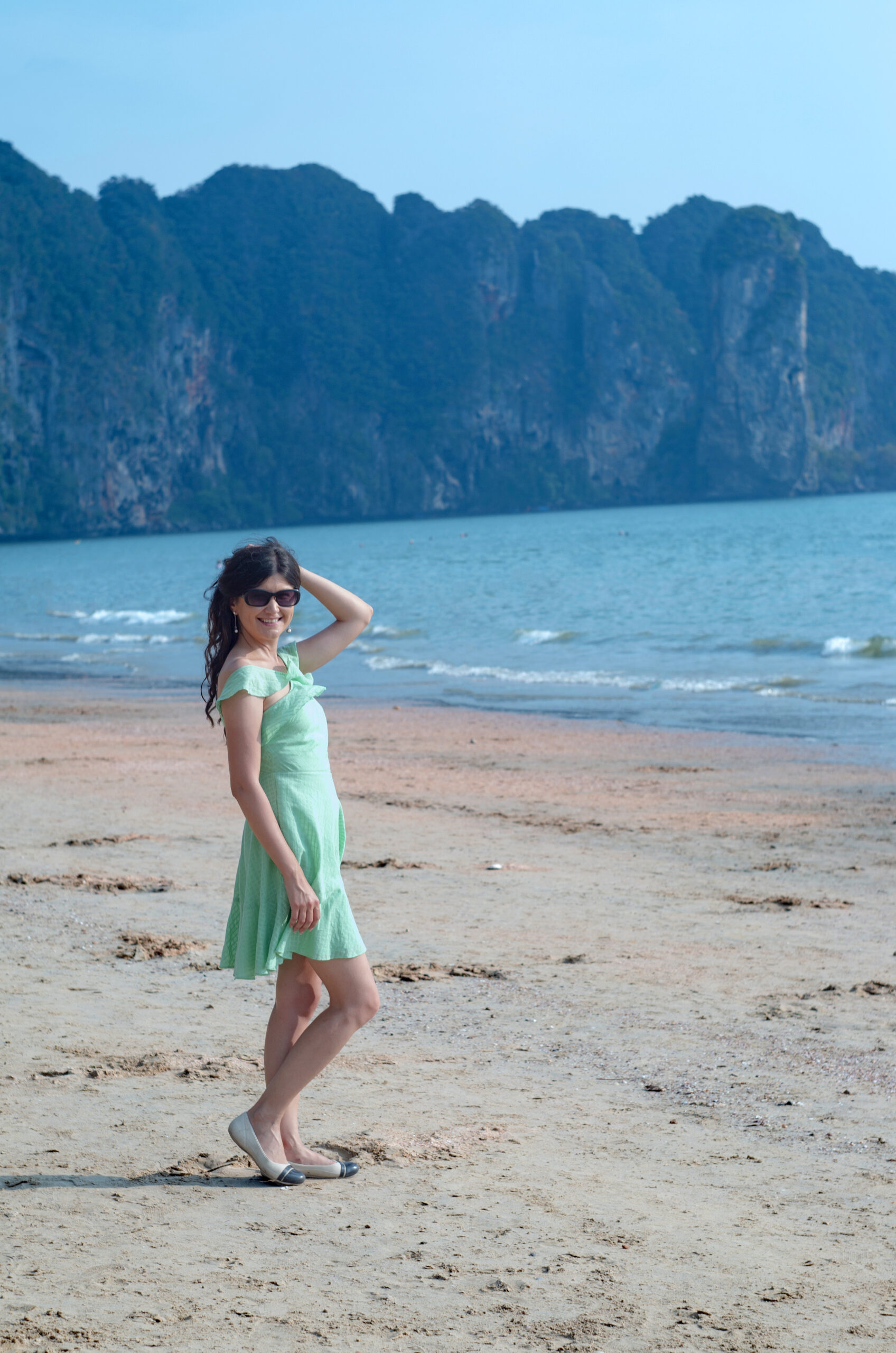
Hello I am Ket,
A traveler, planner, and sweet tooth behind Hit the Road Ket.
Travel isn’t just my passion – it’s a lifeline for my mental health. Having lived in three cities and explored 60 countries (and counting!), I created this blog to share my experiences, smart tips, and itinerary advice with fellow travel lovers. I’m all about making the most of limited time, finding scenic routes, and turning every trip into something memorable – coffee in hand, of course.

